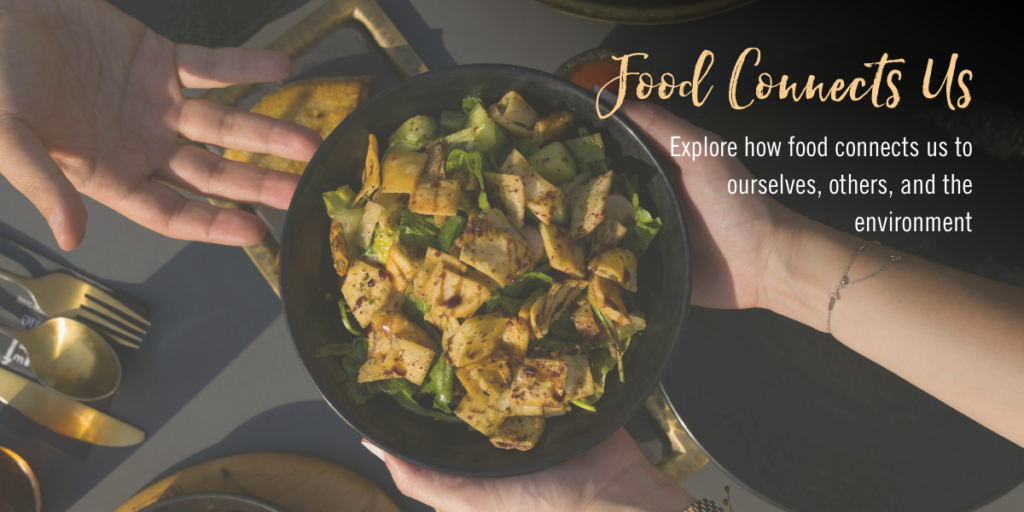Food Connects Us: National Nutrition Month

March is National Nutrition Month, and the theme for 2025 is Food Connects Us. “What does food connect us to?” you may ask. While there are many things that food can connect us to, there are three overarching categories: ourselves, others, and the environment.
Ourselves
If you are reading this article, you may already value food as a piece of our identity. Food is an essential part of daily life, so it’s important to understand our connection or relationship with our food. Many things can drive this connection, such as culture, taste, nostalgia, economic stability, emotion, and our desire for health. Exploring how these factors drive your connection with food can help you understand yourself better and make food choices that will help support your needs, values, and goals. A Registered Dietitian can also help you explore this connection as you work towards your health and nutrition goals.
Some ideas on how to explore your connection to food:
- Eat mindfully
- Slowing down allows for more presence and enjoyment of each bite. Notice the flavors, textures, and aromas
- Reduce distractions like screens to focus more on the food you are eating.
- Practice gratitude
- Before eating, take a moment to acknowledge the effort that went into the food- whether it’s from nature or the hands that prepared it.
- Express gratitude for the nourishment food provides and the people involved in its journey to your plate
- Reflect on your emotions
- Keep a journal to write about your meals and how they make you feel. This can reveal emotional connections and patterns. Notice if certain emotions lead you to crave specific foods and explore those triggers or connections with a Registered Dietitian or Therapist.
Others
Food is one of the many tools we use to connect with those around us. Consider when you have wanted to connect or spend time with others. You may have asked a friend if they wanted to grab lunch with you. Maybe you invited them over for dinner. Or you hosted a party and served snacks and appetizers. Food is often the central part of gatherings. It’s a way to help facilitate the creation and growth of social bonds. Our conversations over food and meals can deepen our relationships and fulfill our need for belonging.
Sharing meals is a great way to connect with your community. Here are some ideas to help you explore this connection:
- Host a potluck
-
- Hosting a potluck dinner party can help create a sense of community and connection around food.
- Volunteer
-
- Participating in community kitchens or food banks will help you to connect with others through the act of sharing meals.
Food can also help us build connections with different cultures. Exploring various cultural foods and food traditions can help us understand a culture’s values, history, and celebrations.
Ideas for exploring cultural foods:
- Try a new recipe
-
- Taste dishes from different cultures to expand your palate and experiment with a new recipe to appreciate diverse food traditions.
- Do some research
-
- Research the origins and significance of the ingredients used in various cuisines.
- Visit an international grocery store
-
- Visit an international grocery store to browse through products and find a few that intrigue you to bring home to try.
- Host a cultural food exchange
-
- Host a cultural food exchange by inviting friends from different backgrounds. Have everyone bring their favorite dish to share a meal and experience everyone’s cultural foods.
The Environment
The connection that food has to the environment may not be as obvious, but it is still very important. What foods we choose to eat, when, and how we eat them can all impact the environment. Food production contributes to greenhouse gas emissions, which are a major driver of negative environmental impacts.
Here are some habits you can implement to help decrease the amount of greenhouse gasses in our environment:
- Buy seasonal produce
-
- It can be easy to get into the habit of always buying the same fruits and vegetables, but buying produce that’s in season typically reduces our carbon footprint. Not only can buying seasonal produce help the environment, but it can also be a budget-friendly way to diversify your diet.
- Visit https://www.seasonalfoodguide.org/ to see what produce is in season in your area and for ideas on incorporating it into your meals.
- Add more plants to your diet
-
- The production of fruits and vegetables tends to produce lower amounts of greenhouse gasses when compared to animal products such as meat, eggs, and dairy.
- Reduce food waste
-
- No matter what your eating habits look like, there are ways that you can reduce food waste in your home. Some ideas include eating leftovers, freezing food for later, planning your meals to minimize waste, and storing food properly so it doesn’t spoil as quickly.
Our Invitation to You
In celebration of National Nutrition Month, we invite you to explore these different connections with food! If you are inspired and looking to explore all three connections – ourselves, others, and the environment- consider inviting friends over to make our new Vegetable Peanut Curry recipe, while taking turns sharing gratitude from the meal!
Thank you for celebrating National Nutrition Month with us! You are always welcome to talk with one of our Registered Dietitians to help strengthen the connections important to you while achieving your wellness goals.
Resources
- https://www.seasonalfoodguide.org/
- https://www.eufic.org/en/healthy-living/article/are-seasonal-fruit-and-vegetables-better-for-the-environment
- https://www.usda.gov/foodlossandwaste/why

